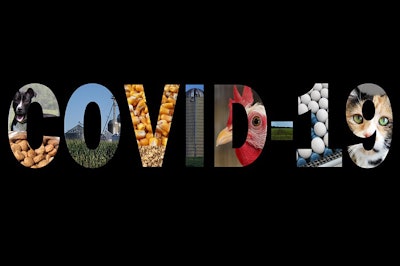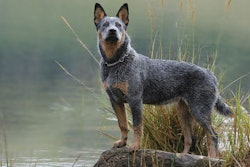
The COVID-19 pandemic has reinforced how intricately human and pet food supply chains are connected, said Dave Fairfield, senior vice president of feed services for the National Grain and Feed Association (NGFA). A slight change in one supply chain can easily impact others.
Fairfield was one of three experts providing U.S. supply status and projections for three fundamental pet food ingredient categories – poultry meats, rendered proteins and grains and seeds – during a Petfood Industry webinar, “Pet food and COVID-19, part 3: key ingredient outlook,” the final installment of a series on how the pandemic is affecting the industry and market.
Poultry market still volatile but steady for pet food
Leading off the webinar, Mark Jordan, executive director of LEAP Market Analytics, illustrated the interdependence of human and animal food supply chains with data on the poultry supply in the U.S., particularly chicken. After several pork and poultry slaughtering plants in the U.S. had to temporarily close in April due to outbreaks of COVID-19 among workers, the human food supply experienced a “historic collapse,” Jordan said, in slaughter and processing capacity.
However, the backlog of animals awaiting slaughter is clearing up faster than expected, he added. In aggregate, demand for chicken and turkey is languishing (which had started with turkey before the pandemic), but the effects are uneven across the various parts and types of poultry products, including those that typically go into pet food.
In other words, we can expect continuing market volatility, including possibly additional supply disruptions later this year, particularly if the U.S. experiences a second major wave of COVID-19 cases, Jordan said. Yet the supply of parts and types of chicken especially that traditionally go into pet food – pet-food-grade mechanically deboned chicken (MDC) as well as rendered products – has remained fairly steady throughout 2020. Since 2000, in fact, pet food’s share as a major broiler market has held at just over 10%, his data showed.
And yes, while the price of pet-food-grade MDC has spiked recently, that’s a familiar pattern this time of year, according to Jordan’s data. Overall, the price has trended upward since 2002, though it’s still down from a high in 2012-14 when more MDC was exported. Jordan projects the price to level off through the end of 2020, then rise again the first half of 2021 but end that year below the level expected for the last several months of 2020.
Rendered pet food proteins have positive outlook
David L. Meeker, senior vice president of scientific services for the North American Renderers Association (NARA), delved into the rendered proteins market touched on by Jordan. Of the 15.7 million tons of livestock and poultry products rendered annually in the U.S. and Canada, 8.9 million tons of rendered protein meals are produced, with 1.5 million tons ending up in pet food, he said.
In addition, 6.3 million tons of refined animal fats produced annually lead to 289,000 tons used in pet food. Combined with the meals, that represents 11.5% of all rendered products that are used in pet food. And, aside from those rendered products, 1.83 million tons of fresh and frozen meat and poultry by-products (including the MDC Jordan discussed) and organ meats go directly into pet food.
According to a study that NARA conducted in 2019 in collaboration with the Pet Food Institute and IFEEDER (the education and research foundation of the American Feed Industry Association, or AFIA), meat and bone meal is by far the largest category of rendered protein meal ingredients used in pet food; at 635,652 tons annually, it’s nearly twice as large as the next category, chicken by-product meal. A main source for the meat and bone meals is pork, Meeker said, even if it’s often not labeled that way.
When pig slaughtering plants were closed in April, so were the rendering sides of those businesses, resulting in a large dip in supply of rendered materials. “Pork supply is very closely tied to production and very much just-in-time in terms of delivery,” Meeker said, and despite farmers’ efforts to slow growth of pigs, there is still a huge backlog of them waiting to be slaughtered that will likely continue through the end of 2020. However, in terms of pet food supplies, a good portion of the materials from those pigs are being rendered after slaughtering; Meeker estimated that at least 1 million pounds of the pigs recently went to rendering, not to the human food chain.
The chicken supply chain is different and a had much larger inventory to start with, so the shutdown of a few chicken processing plants did not have as much of an impact on pet food; it just changed some of the cuts available to pet food, Meeker said. In April, he maintained that any shortages were localized and small scale; and in the recent webinar, he reiterated that point.
A recent release from the U.S. Department of Agriculture said the meat industry is 95% back to normal, while chicken is 98% back. Meeker said he believes that’s more optimistic than other data show, but it’s still good news.
(Note: Meeker will be a speaker for the new Petfood Forum CONNECT virtual event in September 2020.)
Grain, oilseed and pulse status, plus impact on pet food labels
Fairfield of NGFA provided an overview of the production and usage of major U.S. grain crops (mainly corn, plus sorghum, barley and oats), oilseeds (including soybeans, canola and flaxseed) and pulses (dry beans and peas, plus lentils). As of May 2020, production of grains and oilseeds is down this year but projected to rebound in 2021; with pulses, 2021 production is expected to decline slightly again. Yet for pet food suppliers, any shortages of these ingredients have been localized and short term, Fairfield said.
The most significant impact from the pandemic has happened with the supply of dried distiller grains (DDGS), a by-product of ethanol production, which dropped precipitously in the U.S. in April and May. It’s projected to rebound through the end of 2020 and on into 2021. Some categories of DDGS have been at only 85% of normal supplies, and while not all are used in pet food (though some, such as corn gluten meal, are), such demand and supply changes ripple throughout supply chains. Thus, Fairfield’s comment about how intricately supply chains are connected.
Another example: Ingredients such as wheat midds and wheat bran experienced supply disruptions, mainly due to a decrease in flour milling. Yet those also were localized and have proven to be short term, Fairfield said.
He also addressed temporary food labeling changes arising from the pandemic and issued by the Food and Drug Administration (FDA), explaining that they do not apply to animal feed or pet food. He said his organization and others, such as AFIA, are in constant communication with FDA’s Center for Veterinary Medicine (CVM), whose officials don’t expect any industry-wide labeling changes for pet food. Rather, if pet food companies have questions related to ingredient shortages and how they might affect their product labels temporarily, CVM will handle those on a case-by-case basis.
View our continuing coverage of the coronavirus/COVID-19 pandemic.
















